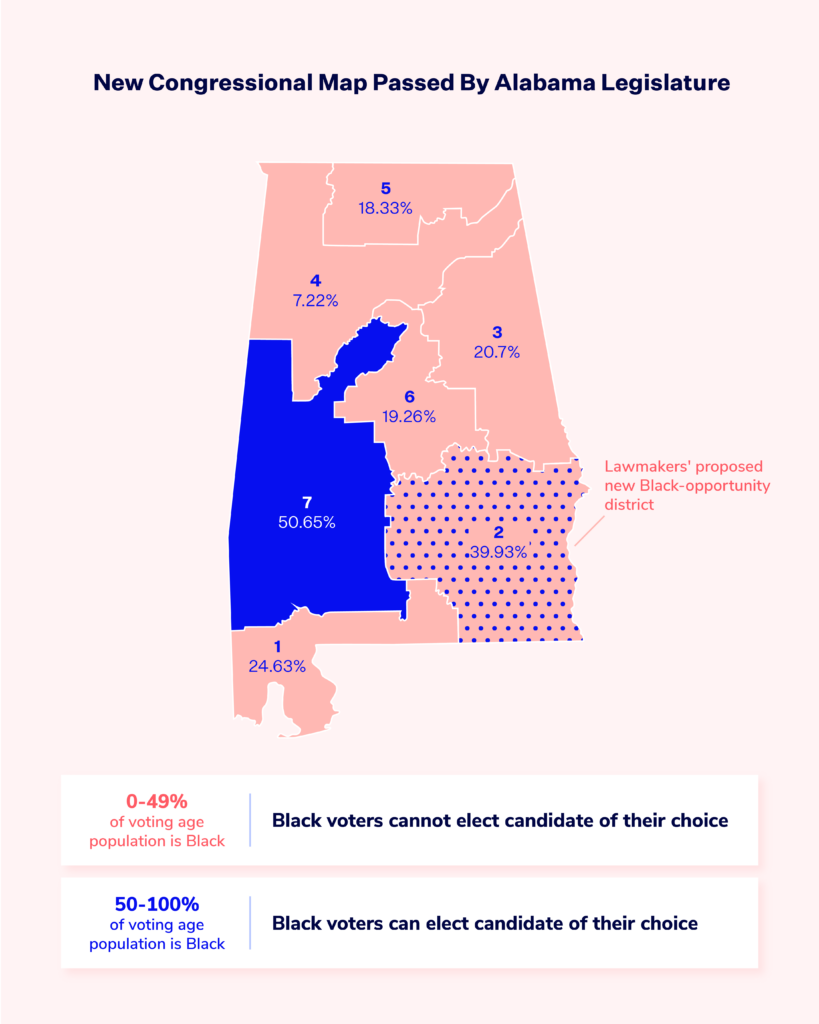Alabama Republicans Send Congressional Map Without Second Majority-Black District to Governor
UPDATE: On Friday, July 21, Alabama Gov. Kay Ivey (R) signed the new congressional map into law.
WASHINGTON, D.C. — On Friday, July 21, the Alabama House voted 75-28 to pass a new congressional map without a second majority-Black district in defiance of a federal district court order.
This new plan, called “Livingston Congressional Plan 3,” was passed by a conference committee and the Alabama Senate earlier today, so it will now head to Gov. Kay Ivey (R) for her signature. This plan has a Black voting age population of 39.93% in the state’s 2nd Congressional District and 50.65% in the 7th Congressional District.

The plan, which clearly lacks a second district that would allow Black voters to have the opportunity to elect the candidate of their choice, plainly violates the district court’s 2022 order stating that “any remedial plan will need to include two districts in which Black voters either comprise a voting-age majority or something quite close to it.” The passage of this plan comes after Republicans advanced two other plans that similarly lacked a second majority-Black district and voted against alternatives that would have ensured two majority-Black districts.
According to reporting, the sponsor of the Livingston Plan, Steve Livingston (R-Scottsboro), stated that he spoke with U.S. House Speaker Kevin McCarthy (R-Calif.) and McCarthy said “I’m interested in keeping my majority.”
Alabama Republicans refusal to pass a map with two majority-Black districts comes just weeks after the U.S. Supreme Court affirmed a district court decision that struck down the state’s original congressional map for likely violating Section 2 of the Voting Rights Act (VRA). Despite the district court ordering Alabama to pass a map with two majority-Black districts, Republican legislators passed a map that only contains one.
Alabama’s road to a new congressional map has been a long and winding one. In November 2021, two lawsuits were filed on behalf of voters and pro-voting organizations alleging that Alabama’s congressional map violates Section 2 of the VRA. A district court blocked the map and ordered the creation of a new map with two majority-Black districts.
On June 8, 2023, the Supreme Court affirmed the district court’s decision that blocked Alabama’s congressional map for likely violating the VRA and ordered Alabama to redraw its map to include a second majority-Black congressional district.
Shortly after the Court’s ruling, the plaintiffs in the case provided the Legislature with a map that contains the two required majority-Black districts entitled the VRA Plaintiffs’ Plan. Public hearings were held, but Republicans never introduced their plans during these public meetings. In an interview with Democracy Docket, Alabama Rep. Chris England (D-Tuscaloosa) explained: “Neither one of the proposals that you see Republicans currently arguing between in the House and the Senate have withstood any public scrutiny. They were both introduced after the public hearings.”
Despite Sen. Vivian Figures (D-Mobile) and England providing the VRA Plaintiffs’ Plan to the Legislature, Alabama Republicans advanced their own plans that contain only one majority-Black district. England explained, “Interestingly enough, if they had just agreed on our map, we would likely be sailing our way to a court where they sign off on it and we would move on. But they would much rather blatantly violate the order, use a losing argument in hopes of either overturning Section 2, or delaying this process long enough to use this illegal map for another election cycle.”
By passing a non-compliant map, the Republican-controlled Legislature is blatantly ignoring that ruling. England underscored this critical point: “I think, if you Googled the word non-transparent, the process that we use to pass these maps would come up. And if you then turned around and Googled non-compliant, you would see the two maps that the Republicans have produced in this process.”
The Legislature’s plan will now go to the governor’s desk. If enacted, the plaintiffs will be able to file objections with the court by July 28. If necessary, a hearing will be held to address concerns over the map on Aug. 14.
The map passed by the Alabama Legislature can be found here.